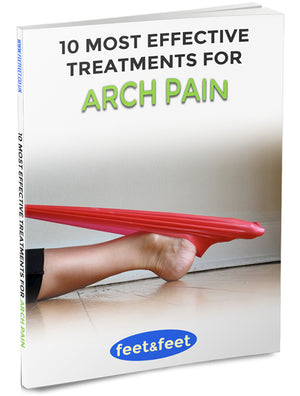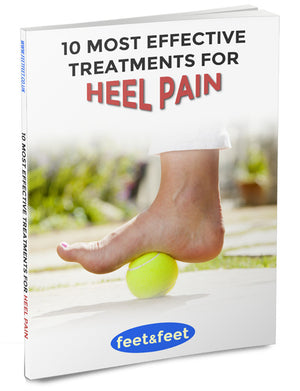What is a Heel Spur?

Have you ever felt a bony growth poking out below the bone in your back heel? Chances are you have stressed your foot and have now developed a condition known as a “heel spur.”
Sometimes, you may not even realise that you have a heel spur until pain in the heel causes you to seek treatment.
If you want to know more about this condition, this article explains what a heel spur is, the symptoms and how to treat it.
Description of a Heel Spur
A heel spur, also called a calcaneal spur, is a condition where calcium deposits create a bony growth in the back of the heel. The growth protrudes from the underside of the heel and can extend for as much as half an inch. This condition develops over time in about 15% of people and is often painless, although it can cause heel pain.
Although different, heel spurs are often associated with plantar fasciitis which is a painful inflammation of the plantar fascia. The plantar fascia is a fibrous band of connective tissues that connects the ball of the foot and the heel.
Although heel spurs can be removed with surgery, non-surgical treatments such as exercise and anti-inflammatory medications are often recommended for easing associated symptoms.
Symptoms of a Heel Spur
A heel spur usually doesn’t cause any symptoms and you may not see changes in soft tissues or surrounding bones. Usually, you will have to get an x-ray along with some other tests to discover a heel spur.
However, the condition has been associated with a number of symptoms, including:
- Intermittent Pain – This worsens when you are walking, running, or jogging, particularly if the inflammation is at the point of the spur formation. It is particularly worse when you walk or step your foot on the ground after sleeping or resting for a long while.
- Swelling – The back of your heel may swell.
- A piercing pain at the bottom of the feet – Many people suffering from a heel spur describe the pain as a pin or knife sticking into the heel. Also, they report that the pain comes sharply when they first stand up in the morning and dissipates into a dull ache. Furthermore, the pain associated with heel spur returns after standing up after sitting for a long period of time.
- The inflamed area can feel warm to the touch.
- There may be a small but visible bony protrusion.
Causes of a Heel Spur
Heel spurs are a sign the body gives to tell you your foot ligaments and tendons are under duress. They typically occur when calcium deposits build up over time, usually months, on the underside of the heel bone.
Although the main cause of a heel spur is poorly understood, here are a few proposed causes:
- Walking Gait Abnormalities – These abnormalities excessively stress the nerves near the heel as well as the heel bone and ligaments.
- Repetitively running or jogging on hard surfaces
- High-impact aerobic exercises
- Obesity or being overweight
- Wearing shoes lacking appropriate arch support
- Chronic conditions such as type 2 diabetes, arthritis and gout
- Flat feet or overarched feet
Heel Spur Treatments
Heel spur treatments are basically dependent on lifestyle changes and a lot of rest. Here are some effective treatment options for heel spurs:
1. Cold Compresses
Do cold compresses for up to fifteen minutes at once; this can temporarily numb the inflamed area, thus relieving the heel pain.
Cold compresses are the preferred option compared to heat packs for heel spurs; heat packs work better for joint and muscle aches.
2. Therapy and Stretching Exercises
Stretching exercises and therapies are great remedies for overall body conditioning for many reasons. The foremost reason is that they help work out sore muscles and tight ligaments, and they help prevent injuries.
As such, they are excellent for managing and recovering from heel spur pain. Heel spur exercises include seated foot flexes, calf stretches, golf or tennis ball foot rolls, and towel grabs with your toes.
3. Anti-Inflammatory Medications
Your podiatrist or orthopaedic doctor may recommend anti-inflammatory medications like corticosteroid shots, especially if your pain is severe. These drugs help ease the pain and inflammation in the heel as well as the arch of the foot.
4. OTC Pain Meds
You can reduce short-term or even acute pain with the help of over-the-counter pain medications such as ibuprofen and acetaminophen. However, you should inform your podiatrist if you’re taking any other medications or if you have pre-existing kidney or liver problems before you do.
5. Rest
One of the most recommended heel spur treatments is rest; it alleviates acute pain and prevents the condition from worsening. If your pain is particularly severe, your podiatrist may instruct you to rest your foot until the symptoms subside.
6. Orthotic Shoe Inserts
Your podiatrist may recommend orthotic shoe inserts such as heel pads. These give you the heel support and arch needed to relieve heel spur pain.
Also, they can prevent the situation from worsening, especially when they are used alongside proper footwear.
7. Heel Spur Surgery
In cases where pain becomes too severe and other symptoms worsen or don’t respond to treatment, your podiatrist or foot and ankle orthopaedic surgeon may recommend surgery. During the surgery, the heel spur is either removed or the plantar fascia is released.
8. Essential Oils
These can help reduce pain and swelling as they act as natural anti-inflammatory agents. Essential oils such as bergamot oil, eucalyptus oil, fennel oil, lavender oil and thyme oil can be massaged into the heels for further relief.




Leave a comment